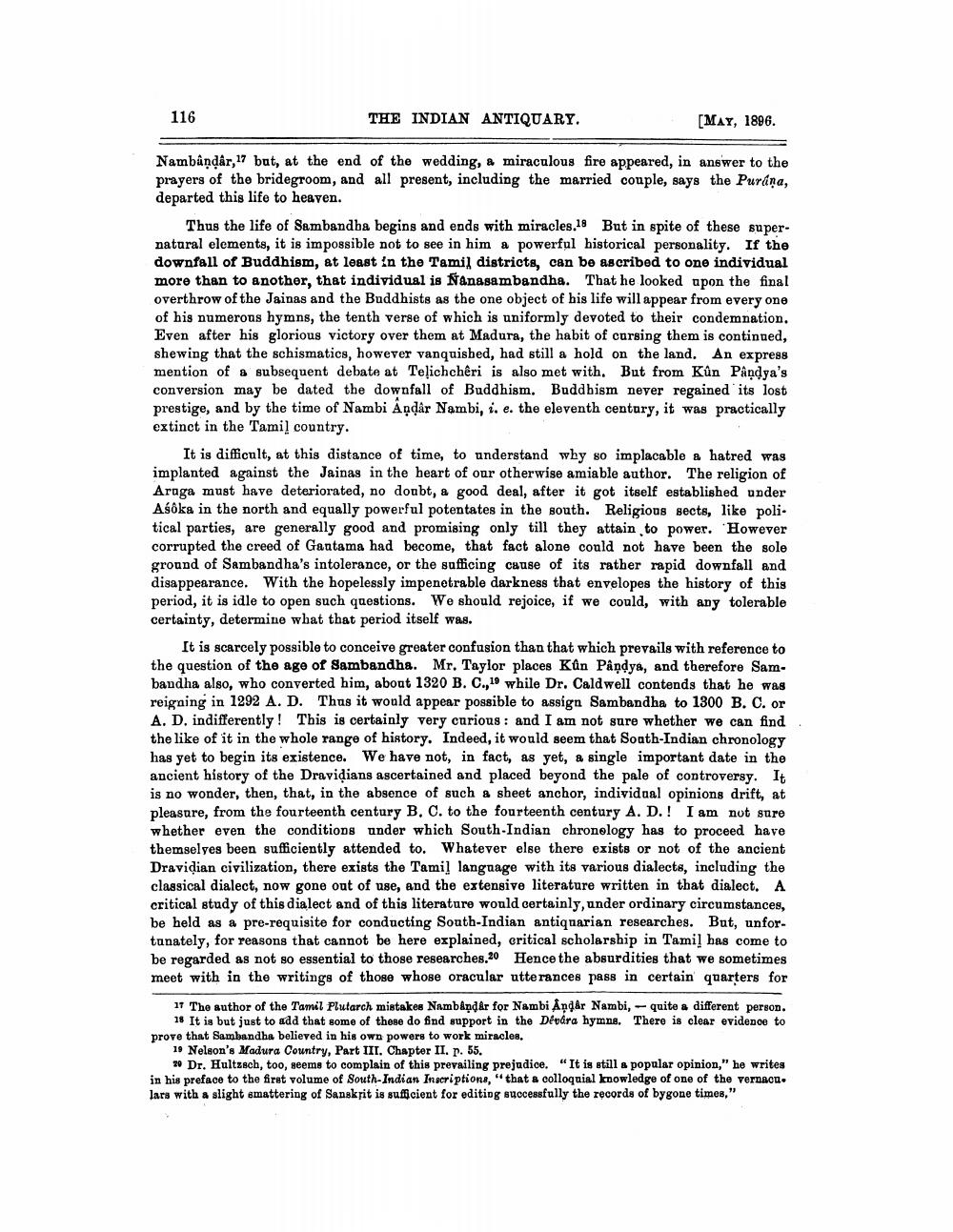________________
116
THE INDIAN ANTIQUARY.
Nambâṇḍâr, 17 but, at the end of the wedding, a miraculous fire appeared, in answer to the prayers of the bridegroom, and all present, including the married couple, says the Purána, departed this life to heaven.
[MAY, 1896.
Thus the life of Sambandha begins and ends with miracles.18 But in spite of these supernatural elements, it is impossible not to see in him a powerful historical personality. If the downfall of Buddhism, at least in the Tamil districts, can be ascribed to one individual more than to another, that individual is Nanasambandha. That he looked upon the final overthrow of the Jainas and the Buddhists as the one object of his life will appear from every one of his numerous hymns, the tenth verse of which is uniformly devoted to their condemnation. Even after his glorious victory over them at Madura, the habit of cursing them is continued, shewing that the schismatics, however vanquished, had still a hold on the land. An express mention of a subsequent debate at Telichchêri is also met with. But from Kûn Pândya's conversion may be dated the downfall of Buddhism. Buddhism never regained its lost prestige, and by the time of Nambi Andar Nambi, i. e. the eleventh century, it was practically extinct in the Tamil country.
It is difficult, at this distance of time, to understand why so implacable a hatred was implanted against the Jainas in the heart of our otherwise amiable author. The religion of Araga must have deteriorated, no doubt, a good deal, after it got itself established under Asôka in the north and equally powerful potentates in the south. Religious sects, like political parties, are generally good and promising only till they attain to power. However corrupted the creed of Gautama had become, that fact alone could not have been the sole ground of Sambandha's intolerance, or the sufficing cause of its rather rapid downfall and disappearance. With the hopelessly impenetrable darkness that envelopes the history of this period, it is idle to open such questions. We should rejoice, if we could, with any tolerable certainty, determine what that period itself was.
It is scarcely possible to conceive greater confusion than that which prevails with reference to the question of the age of Sambandha. Mr. Taylor places Kûn Pândya, and therefore Sambandha also, who converted him, about 1320 B. C.,19 while Dr. Caldwell contends that he was reigning in 1292 A. D. Thus it would appear possible to assign Sambandha to 1300 B. C. or A. D. indifferently! This is certainly very curious: and I am not sure whether we can find the like of it in the whole range of history. Indeed, it would seem that South-Indian chronology has yet to begin its existence. We have not, in fact, as yet, a single important date in the ancient history of the Dravidians ascertained and placed beyond the pale of controversy. It is no wonder, then, that, in the absence of such a sheet anchor, individual opinions drift, at pleasure, from the fourteenth century B. C. to the fourteenth century A. D.! I am not sure whether even the conditions under which South-Indian chronology has to proceed have themselves been sufficiently attended to. Whatever else there exists or not of the ancient Dravidian civilization, there exists the Tamil language with its various dialects, including the classical dialect, now gone out of use, and the extensive literature written in that dialect. A critical study of this dialect and of this literature would certainly, under ordinary circumstances, be held as a pre-requisite for conducting South-Indian antiquarian researches. But, unfortunately, for reasons that cannot be here explained, critical scholarship in Tamil has come to be regarded as not so essential to those researches.20 Hence the absurdities that we sometimes meet with in the writings of those whose oracular utterances pass in certain quarters for
17 The author of the Tamil Plutarch mistakes Nambandar for Nambi Andar Nambi, quite a different person. 18 It is but just to add that some of these do find support in the Devara hymns. There is clear evidence to prove that Sambandha believed in his own powers to work miracles.
19 Nelson's Madura Country, Part III. Chapter II. p. 55.
20 Dr. Hultzsch, too, seems to complain of this prevailing prejudice. "It is still a popular opinion," he writes in his preface to the first volume of South-Indian Inscriptions, "that a colloquial knowledge of one of the vernacu. lars with a slight smattering of Sanskrit is sufficient for editing successfully the records of bygone times,"




